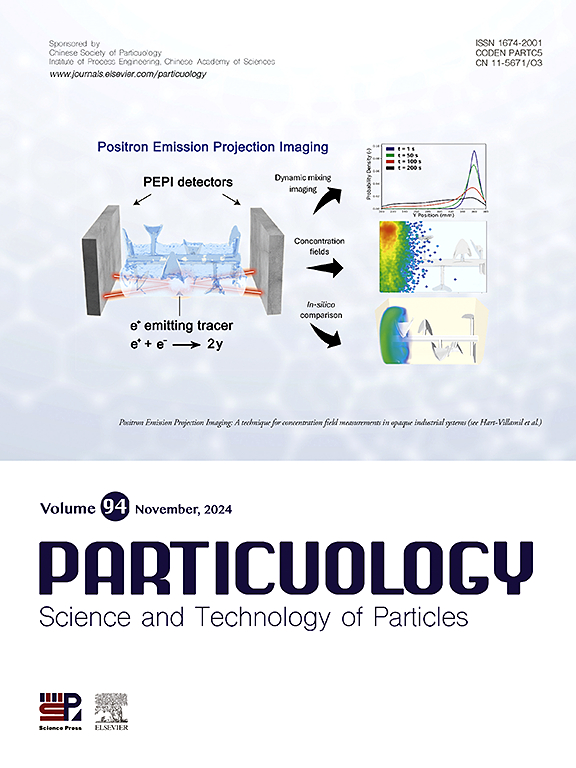Effect of different components in cement raw meal on carbothermal reduction of NOx in flue gas: An experimental study
IF 4.1
2区 材料科学
Q2 ENGINEERING, CHEMICAL
引用次数: 0
Abstract
In China, the cement industry is the third largest source of NOx emissions after thermal power generation and transportation industries. Flue gas carbothermal reduction denitrification technology was proposed by the author team in previous research, and had been proved to be an effective method to cut NOx emissions from coal-fired cement kiln. Based on previous research work, a series of tube furnace experiments were conducted to further clarify the impact laws of different components in cement raw meal (CRM) on NOx reduction when using this method in the present work. Compared with the situation that only pulverized coal exists, adding only calcium carbonate had a slight inhibitory effect on NO reduction, and the maximum reduction efficiency of NO (ηmax) dropped to 63.79% from 66.67%. The addition of oxides such as SiO2, MgO, Al2O3 and Fe2O3 into the mixture of pulverized coal and CaCO3 had an impact on the reduction of NO. Overall, metal oxides promoted the reduction of NO, while SiO2 inhibited the reduction of NO. For positive promotion, Fe2O3 had the most significant effect on the reduction of NO, and ηmax reached 89.71% when the addition amount was 4% compared to 63.79% before addition. The promoting effect of metal oxides on NO reduction is: Fe2O3>MgO>Al2O3. In addition to Fe2O3, the influencing law of addition amount of MgO and Al2O3 on NO reduction had also been revealed. The outputs achieved in this study will provide a reference for how to reasonably adjust the ratio of CRM when the flue gas carbothermal reduction denitrification technology is applied into cement industry.

水泥生料中不同组分对烟气中NOx碳热还原效果的实验研究
在中国,水泥行业是仅次于火力发电和交通运输行业的第三大氮氧化物排放源。烟气碳热还原脱硝技术是笔者团队在前期研究中提出的,并已被证明是降低燃煤水泥窑NOx排放的有效方法。在前人研究工作的基础上,进行了一系列管式炉实验,进一步明确了采用该方法时水泥生料(CRM)中不同组分对NOx还原的影响规律。与只添加煤粉的情况相比,只添加碳酸钙对NO的还原有轻微的抑制作用,NO的最大还原效率(ηmax)从66.67%下降到63.79%。在煤粉与CaCO3混合料中加入SiO2、MgO、Al2O3和Fe2O3等氧化物对NO的还原有影响。总体而言,金属氧化物促进了NO的还原,而SiO2抑制了NO的还原。对于正向促进,Fe2O3对NO的还原效果最为显著,添加量为4%时ηmax达到89.71%,而添加前ηmax为63.79%。金属氧化物对NO还原的促进作用为:Fe2O3>;MgO>Al2O3。除Fe2O3外,还揭示了MgO和Al2O3添加量对NO还原的影响规律。本研究成果将为烟气碳热还原脱硝技术应用于水泥行业时如何合理调整CRM比例提供参考。
本文章由计算机程序翻译,如有差异,请以英文原文为准。
求助全文
约1分钟内获得全文
求助全文
来源期刊

Particuology
工程技术-材料科学:综合
CiteScore
6.70
自引率
2.90%
发文量
1730
审稿时长
32 days
期刊介绍:
The word ‘particuology’ was coined to parallel the discipline for the science and technology of particles.
Particuology is an interdisciplinary journal that publishes frontier research articles and critical reviews on the discovery, formulation and engineering of particulate materials, processes and systems. It especially welcomes contributions utilising advanced theoretical, modelling and measurement methods to enable the discovery and creation of new particulate materials, and the manufacturing of functional particulate-based products, such as sensors.
Papers are handled by Thematic Editors who oversee contributions from specific subject fields. These fields are classified into: Particle Synthesis and Modification; Particle Characterization and Measurement; Granular Systems and Bulk Solids Technology; Fluidization and Particle-Fluid Systems; Aerosols; and Applications of Particle Technology.
Key topics concerning the creation and processing of particulates include:
-Modelling and simulation of particle formation, collective behaviour of particles and systems for particle production over a broad spectrum of length scales
-Mining of experimental data for particle synthesis and surface properties to facilitate the creation of new materials and processes
-Particle design and preparation including controlled response and sensing functionalities in formation, delivery systems and biological systems, etc.
-Experimental and computational methods for visualization and analysis of particulate system.
These topics are broadly relevant to the production of materials, pharmaceuticals and food, and to the conversion of energy resources to fuels and protection of the environment.
 求助内容:
求助内容: 应助结果提醒方式:
应助结果提醒方式:


